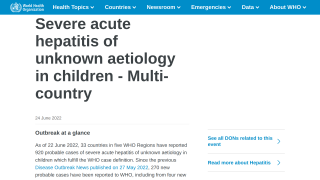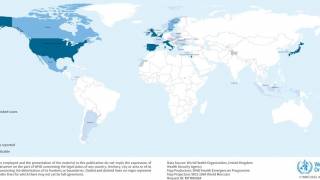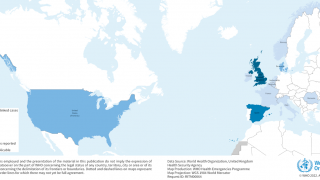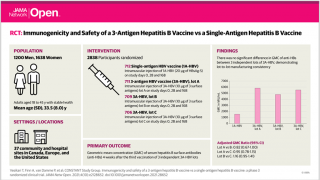Will Hepatitis Be On the Menu in 2020?

When hearing about hepatitis A virus outbreaks, many people think about contaminated foods. However, this viral liver disease is more commonly spread from person to person in the USA.
Since the outbreaks were first identified in Michigan during 2016, the Centers for Disease Control and Prevention (CDC) Division of Viral Hepatitis has reported over 29,000 hepatitis A virus (HAV) cases in 30 states, as of December 20, 2019.
These HAV cases have caused significant costs by generating 17,801 hospitalizations and disrupted 298 families with related fatalities.
The CDC says ‘the 3 largest groups affected by Hepatitis A outbreak are intravenous drug users, the homeless, and men who have participated in sexual intercourse with other men.
Hepatitis A is also spread person-to-person when someone unknowingly eats food, drinks a beverage or places an object in their mouth that has been contaminated with microscopic, trace amounts of the virus.
People infected with Hepatitis A are most contagious from 2 weeks before the onset of symptoms to 1 week afterward.
While the vast majority of HAV cases were reported in the state of Kentucky (4,990) during 2019, the state of Florida (3,644) led most states during the 2nd half of the year.
However, the states of Kentucky, Ohio, and Florida share another aspect of their outbreaks…. HAV-infected food-service staff.
The CDC reported during June 2019, ‘the spread of germs from the hands of food workers to food accounts for about 89 percent of outbreaks in which food was contaminated by food workers.’
Throughout 2018 and 2019, numerous restaurants reported food service staff worked while infectious, potentially spreading the HAV to patrons.
A recent example is the state of New Jersey, which confirmed the following HAV exposures:
- ShopRite of Somerville, between October 30th,
- Brother’s Produce on East Railway Avenue, October 12th,
- Mendham Golf & Tennis Club, June 30th.
And most recently, an Advisory issued by the New York State Department of Health (NYSDOH) and the Bureau of Communicable Disease Control, reporting a 235 percent increase in HAV cases during 2019, compared to the average number of cases reported annually between 2016-2018.
On December 12, 2019, the NYSDOH Health Advisory was sent to healthcare providers in New York, saying there is a ‘Hepatitis A outbreak’, and an increase in cases has been seen in all regions of the state, excluding New York City.
The New York counties of Dutchess, Erie, Jefferson, Niagara, Onondaga, Oswego, and Suffolk have been particularly impacted.
Furthermore, New York’s Advisory says ‘suspected HAV cases occurring in a food handler must be reported immediately.’
This is not the state of New York’s first HAV related restaurant issue.
During August 2019, the Journal News/lohud.com reported several lawsuits are seeking $691,000 in damages connected to a hepatitis A exposure at the Bartaco restaurant in Westchester County, NY.
The Westchester County health department issued the warning after 4 people contracted the HAV in connection to an infected Bartaco worker. And, more than 3,000 people received hepatitis vaccinations.
Paul Nunes, an attorney representing patrons in the cases said to the Journal News/lohud.com, ‘What we’re trying to do is do the right thing by the folks who ate at Bartaco and were exposed to the hepatitis A virus.'
'Every food handler in our country should be vaccinated for hepatitis A. That would stop these kinds of outbreaks.’
Recently, the Alabama Department of Public Health issued a statement ‘encouraging foodservice owners and managers to consider requiring the hepatitis A vaccine for all food workers. While food workers are not at a higher risk than other workers, some fall into high-risk groups and would place customers at risk if they became infected.’
Additionally, HAV outbreaks can be devastating to a restaurant’s economic success.
A Modern Restaurant Management article published on December 31st said ‘just 1 hep A case is devastating – revenue drops an average of 50% in the first week after a case goes public and is still down by 7% or more a year later.’
The CDC says ‘if you are at risk of contracting HAV, get vaccinated.’
A study published in June 2019, investigated under what circumstances people most often receive a hepatitis A vaccination. This study found physician recommendations have been a top influencer of people receiving hepatitis A vaccinations.
“In the context of enhancing patient care, our results underscore the need of increasing awareness among primary care providers of the CDC’s recommendations for vaccinating adults at increased risk for hepatitis A infection,” according to a statement from this study’s research team.
“The CDC recommends the use of evidence-based strategies, such as vaccine standing orders, and provider education programs, reduce missed opportunities to vaccinate eligible persons,” the research team said.
There are three HAV vaccines approved for use in the USA: Vaqta, Havrix, and Twinrix. The most common potential side effect of these vaccines is soreness at or around the injection site.
Furthermore, immune globulin can provide short-term protection against hepatitis A, both pre- and post-exposure.
Any vaccine can cause side effects, which should be reported to a healthcare provider asap, says the CDC.
Hepatitis A vaccine news published by Precision Vaccinations
Our Trust Standards: Medical Advisory Committee
- Michigan Hepatitis A 2016-2019 Outbreak Summary
- CDC: Widespread outbreaks of Hepatitis A across the US
- CDC: Food Safety Practices of Restaurant Workers
- Bartaco hepatitis lawsuit: Judge grants class-action status, what that means for patrons
- Hepatitis A Warning Issued for Grocery Store Customers
- New York Issues Hepatitis A Outbreak Advisory


























